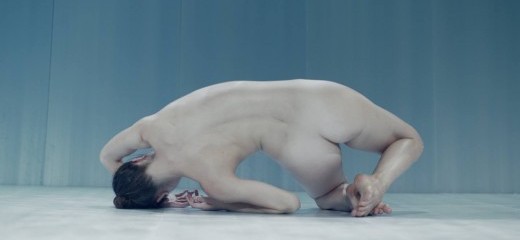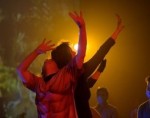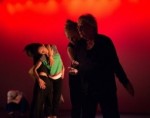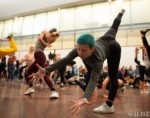
The Body Endures
by Megan Bridge
In our fraught and complicated cultural dialogue around the politics of identity, the body endures: fleshy, knowing, absolutely un-ignorable. Contemporary dance is in a unique position as a site for research on how specifically the body might talk back: artists continue to argue for their practice as not just expressive, but investigatory. Practice as research is a real thing, generating new forms of knowing, and creating new ways to articulate our experience in the world.
At Oktoberdans, a ten-day festival of dance in Bergen, Norway, I saw three solo works that each thought and moved through contemporary notions of gender, pain, and the body.
In Juli Apponen’s lecture performance Life Is Hard and Then You Die, Apponen remains seated at a table with a microphone for the duration of the work. She opens by telling us the date of her birth: February 13, 1981. Later, she tells us that her castration* surgery was on February 14, 2012. Though she doesn’t make it explicit, the birth/re-birth connection is clear.
Between 2012 and 2017, Apponen braved nine surgeries in order to complete a male-to-female gender transition. The clinical description of these, preceded by their date and location, provide a chronological framework for the hour-long performance. Into this structure, Apponen weaves brief personal anecdotes, diagnoses, descriptions of her psychiatric evaluations before and during the course of her gender transition, dreams, ideas for art projects, memories of conversations, and sexual encounters.
Apponen’s delivery is dry: she shows no emotion throughout the course of her performance. Though she shares personal stories and lived experience, she leaves the interpretation to us. The power, emotion, and beauty in this work comes through in what is not said. For example: when Apponen was in nursery school, she told her teacher one day that a man named Hans, who lived with her, would be picking her up from school. Hans was her father. When she was little, Apponen was asked to draw a picture of her family, and she refused because “there were too many.” She grew up in a hippie commune of three families. What’s left out of these stories is where the pain resides.
Apponen uses often excruciating detail to describe her nine surgeries, sometimes demonstrating by poking a pencil through a piece of paper when words aren’t enough. Her phenomenological approach foregrounds her lived experience; the body becomes a site through which the audience can begin to understand the pain—not just physical—of Apponen’s existence.
Daina Ashbee’s Pour opens in pitch black to the sound of performer Paige Culley’s high, piercing screams, which punctuate the softer scuffling of her feet over the floor. When the lights finally come up, she’s standing before us, topless, in jeans. She meets the audience’s eyes, and a slight smile plays across her lips. After some false starts, she take off her pants, a guttural uhhhhhhhhhhh emerging from her throat. Eventually making her way to the floor, Culley slowly rolls over and over around the perimeter of the stage, and I think of the work’s title. It’s as if she’s pouring her body from one side of herself to the other, gradually sequencing the weight of her bones in an architectural unfolding.
There is a kinesthetic logic in this dance that Culley is completely in control of at every moment. Later, she pounds the soft floor (made of flat, interlocking pieces of styrofoam) repeatedly, starting with her elbows and then using other body parts (leg, pelvis, belly). Audibly, it resembles a sex act, and the addition of her breathy “oh oh ow ow uh uh” contributes to this. Culley looks back at our looking, and again, I read visible amusement on her face. Jean-Francois Blouin’s environmental sound score—with chords like fog horns, open strings, organ pipes—creates a massive container for this work, sometimes overpowering the space with sound and other times leaving room for Culley’s contributions.
Finally, Culley sits up. Her mouth is open. She subtly sucks in air, then burps. I swear I can smell her burp, but surely this is my imagination? In any case, here the choreography becomes physiological, in addition to aural, kinesthetic, and visual. Culley starts shaking, bouncing, and moaning again, this time on her knees, gradually scooting back. Her sounding grows and intensifies till it becomes almost a growling. I get goosebumps—the sounds she is making are just like what I remember from giving birth. A granularity enters her scream, again reminding us of her humanity. Her voice is tired. The work ends with Culley step-touching back and forth across the front edge of the stage, her back to us.
Some of the men that I spoke with after the show felt that this solo was yet another example of the objectification of a naked woman’s body. But perhaps their reaction was more about their own practiced gaze when confronted with a white, female-bodied performer who conforms to Western standards of beauty (small waist, curvy hips, high, full breasts). To me, performer Paige Culley was a powerfully human subject with legible agency for every moment of this carefully nuanced solo dance.
Daniel Mariblanca opens his show, 71Bodies 1Dance, by addressing the audience directly. He is humble, but confident, and excited to share the work. He wears running shoes and sweats, but disrobes almost immediately. Again, the body becomes a discursive site. The absence of a penis, and Mariblanca’s almost-flat chest, doesn’t come as a surprise—I know that this piece is by a trans man. What surprises me, as the performance continues, is that I never once waiver in my parsing of his gender as male.
After undressing, Mariblanca takes center stage. His movement is barely perceptible at first, and then seems physiologically driven: his stomach starts to roll. Over the course of several minutes, this movement gradually builds into full spine undulations, and then repeated whipping back bends. Mariblanca’s abdominal muscles ripple; he’s covered in sweat. He finally leaves center stage and traverses the space. Some virtuosic pitch turns and a headstand that becomes a jarring front flip are thrown in for effect. Finally, Mariblanca ends up upstage, where he’s metaphorically “born”: pitched forward, his bald head leads the rest of his body in a movement that repeatedly pushes and then retreats. In case we didn’t get the reference, Mariblanca lets out a very convincing newborn-sounding cry. Soon after, he’s pitched over again, downstage this time, and retches over and over again, until I’m convinced he’s going to make himself throw up. It doesn’t happen, but the pain of these moments leaves an indelible mark.
71Bodies 1Dance, with all of its intensity, is not without humor. At one point the music stops, and Mariblanca addresses us directly again. After a substantial lead-up about a new song he created, that came to him in a vision one sleepless, snowy night in a hotel room in Oslo, he finally sings the song. Pounding his fist on the heel of his opposite hand to keep time, Mariblanca sings the song, first whispered, then loud and clear: “Pussy. Dick. Pussy. Dick. Pussy. Dick. Pussy. Dick….” There is a sudden and very palpable levity in the house. I imagine everyone silently agreeing about the absurdity of the West’s Cartesian obsession with binaries.
Mariblanca initiated his project 71Bodies 1Dance with a two-year research process during which he interviewed and documented encounters with 71 transgender people. Before the performance, audience members could peer into black boxes scattered throughout the lobby, and (with headphones) watch and listen to short films created about some of the participants. Afterwards, the audience was led en masse through double doors at the back of the theater, into a gallery which displayed photographs of each of the 71. Brief statements (in their own words) appeared below each portrait.
I watched these three solos all in one day. The next day I attended Across & Beyond: A lecture and conversation on art, body & gender, part of the festival’s discursive platform. This gave me a framework to flesh out my experience. Interestingly, Pour was not included in the “RE:GENDER” platform that Mariblanca’s and Apponen’s works were a part of, though to me it spoke just as loudly about gender as the others. Either way, these three works in conversation with each other, and followed by the discourse event, exemplified curation at its best. Oktoberdans gave artists a place to share their most current, searingly relevant research, and audiences a chance to grapple together with some of the most thorny questions of our time.
* I am grateful to my thINKingDANCE editor for pointing out that generally “gender affirmation surgery” is preferred over “castration” in 2018. However, since the artist used the word castration to describe her surgery, I have chosen to leave it here.
Oktoberdans, October 18-27, bit teatergarasjen, Bergen, Norway.
By Megan Bridge
November 15, 2018










